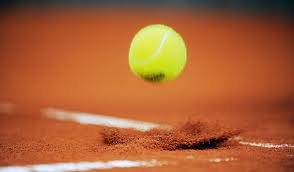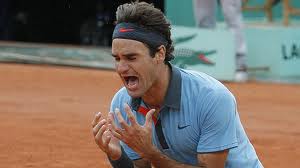Clay - time to rebuild and rethink!
Statistically if you look at the professional game, it is playing on clay that has determined a player's development. Most pros have had an extended period honing their skills on the red stuff.
Coming from England I learned my tennis chiefly on grass or on tarmac. Tarmac goes under various names all over the world, but I'll call it unromantically tarmac. Although tarmac is not a pro tennis surface, and would be nobody's favourite, it is the nearest hard court to clay in terms of playing characteristics. The ball bounces high, and slowly. It grips, and spins, but not excessively. As soon as you can cause a surface "slow", it starts becoming a good surface to learn on. Ironically the French call tarmac "Quick"! When playing on tarmac, you should exploit the bounce, that is put plenty of topspin on the ball, and work long rallies, making your opponent tired. If you're not fit yourself, you're going to struggle on tarmac.
Grass is a great, all court, shot-making , touch-developing surface. You use touch much more than brute force. To succeed on grass you need variety, great reactions and plenty of creativity.

Beginning on clay
Being an inexperienced, untrained, player I had become in England a doubles specialist, because that is all we played. On tarmac doubles gets relatively long rallies, but not enough to make you realise that exhausting long rallies ARE the principal ways of winning on tarmac. Doubles on grass is a delicious mix, encouraging volleying, variety and reactivity. Those were the chief skills that I arrived with when I came to Germany and had to play on clay for the first time.
I came to my Bavarian club as the club pro, did some coaching in the hall on carpets, then came the clay season. The Germans have sensational clay facilities, but another misnomer, they call it sand! It is not sand at all, but crushed brick. Bricks are made from clay, so clay it is! The clay season starts late, at the beginning of May, suffers some extended holidays in June, but by the middle of July everyone has gone on holiday, and those super courts are deserted. Coming back from holiday not a lot is going on, so the clay season is only about ten weeks long. The Germans sometimes try to extend the clay season by taking February or March holidays in Turkey or Croatia to learn about clay again before they start on the clay. Clay gains even more importance when you realise that there is almost no tennis club competition in winter. All the indoor facilities are private, and mostly not linked to the clubs, so fitting in a one or two week tournament slot would end up by being very expensive. There are winter tournaments, and they are indeed expensive.
In my first season in May I had to play the club internal tournament. I was enjoying playing on clay, and got to the quarter finals with no problem. I then came against the Number five in the First team, theoretically not as experienced as me, but certainly more experienced than me on clay. He was young and fit, and liked spinning the ball, and keeping the ball in play. I came out and played my game of variety and attack, and even though it went over three long sets, I played totally the wrong game strategically and technically. I just couldn't keep the ball in play. The head coach gave me a real dressing-down after my defeat, and told me to learn how to play on clay, and be sharp about it.
Later on I went on my first French circuit, and played some September tournaments on clay, and only then did I start settling down. I didn't get my first "result" on clay, as a confirmed clay player, until two years later when I beat a highly ranked clay specialist, again in France.

Clay fit
Clay isn't easy. It is the hardest surface to learn to play match tennis on because it is the game where you need to be the fittest. Getting fit takes time, and worse, it is a certain sort of fitness. It is less about explosions of speed, more about endless stamina, and great body strength, because shot production needs more physical effort on clay than any other surface. If you preparation isn't based on stamina, and body strength, then your game will fall apart.
We take our examples from those with great records on clay, like Nadal, Borg, Vilas, Wilander, Kuerten, Lendl, or my personal favourite, Muster. These players are by no means identical, but Vilas, Muster and Nadal are certainly similar - strong as oxen, and not uncoincidentally, lefties. Whatever anyone tells you, lefties do play differently. They have stronger, and more trust in, wrists. They spin the ball naturally, especially topspin. Also somewhat curiously, with the exception of Muster; lefties often have far more limited backhands than their forehands, they often slice or shovel their backhands. Muster had a vicious topspin backhand, to go with his forehand, so he had great equilibrium. It must have been difficult to know where to hit to him, because the ball came back identically on each side.
Most clay players don't serve particularly strongly. Hit a serve hard on clay and the slowness of the surface takes all the speed out of the ball. Spin variations are essential, but also you need a flat ball, absolutely flat. That is the only serve that can get through the slow top layer. So Kuerten was a great sand court player, like Lendl, because his serve was perfect for that surface. A great spin serve, but a beautifully well-disguised flat ball. For a tall man, he was very light on his feet, so he was a great mover. His stamina was excellent. Lendl, also a tall but heavier man, made up his stamina by a brutal training regime to make his legs stronger.
Borg and Wilander grew up on Swedish clay, like German, which is particularly slow (French clay is faster). The extreme slowness of their clay suited their games because, to save energy, they had success by spinning the ball slowly or softly. They were just ball machines, spinning the ball high over the net with little risk.
Although these are the main player types who we can consider to be clay specialists, there are other who have, at least at times, played really well on clay. Federer has a wonderful clay record agaisnt everyone except Nadal. Technically Federer does not do body strength shots, nor strategically does he want long rallies. Although he is super fit, he has more of a Borg type fitness than a Nadal or Vilas one. Nadal will always win the stamina, or big physical shot game. Federer does play beautifully on clay, but my own favourite is Michael Stich. He lost in the Paris final to Kafelnikov in 1996, but his all court tennis was sublime. Edberg and Henman have also had good tournaments on clay, all of these players very willing volleyers, but also good servers. Just to show that you don't just have to have strong legs and spinny groundshots to succeed.
At lower level clay is an essential surface to learn on because it develops fitness and body strength so well. Stich didn't win more on clay because his body wasn't strong enough. Just as you know that your body is in for a rough time on clay, the good news is that otherwise the surface is very forgiving. The body is not likely to pick up injuries - it is a very natural surface to play on.
You have to develop and understand spin, physically, technically produced spin. Even if you are not really a spin player, by playing on clay you learn a lot about the shapes that you can develop on the ball. In practice you don't use all these shapes all of the time, you will tend to stick with one type of shot, for long rallies, that saves your energy, but still creates opportuniites.
In France the clay season is very long - a good five months. A prolonged circuit in France is a must for any developing tennis player.
